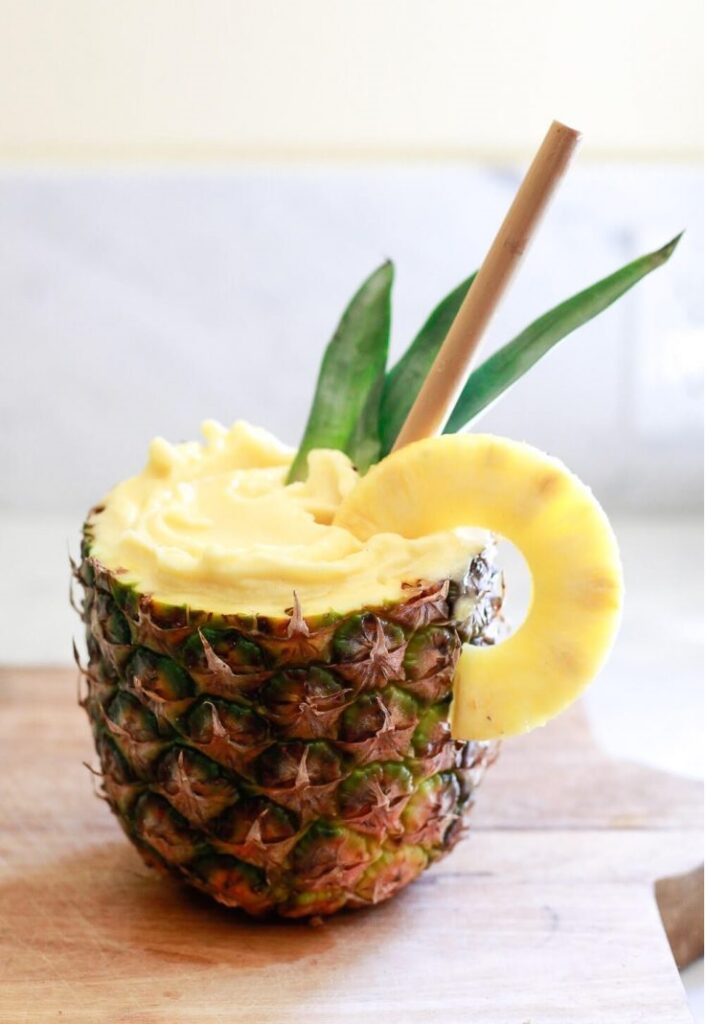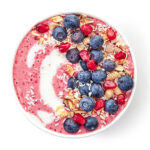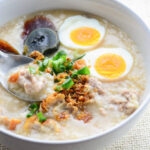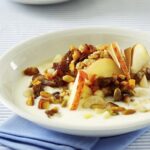A pineapple smoothie is a refreshing and tropical beverage that combines the sweet and tangy flavor of fresh or frozen pineapple with other complementary ingredients. Typically made by blending pineapple chunks with ingredients like yogurt, coconut milk, banana, and ice, pineapple smoothies offer a delightful and nutritious treat. The result is a smooth, creamy concoction with a burst of tropical goodness, perfect for a quick and healthy snack or breakfast option. Customize the recipe to suit your taste preferences, adding ingredients such as spinach, mint, or protein powder for added nutrition and flavor.
| Ingredients | |
| 1 | 1 cup fresh or frozen pineapple chunks |
| 2 | 1 ripe banana |
| 3 | 1/2 cup plain yogurt (Greek yogurt or coconut yogurt for a creamier texture) |
| 4 | Half a cup coconut milk, or any other type of milk you prefer |
| 5 | 1/2 cup ice cubes |
| 6 | Optional: honey or agave syrup for added sweetness |
| 7 | Optional: a handful of spinach for added nutrition |
| 8 | Optional: a squeeze of lime juice for extra freshness |
Step-by-step cooking instruction of Pineapple Smoothie:
Step-1 Prepare Ingredients:
- Peel and chop the ripe banana.
- Measure out the pineapple chunks, yogurt, coconut milk, and ice cubes.
Step-2 Blend:
- In a blender, combine the pineapple chunks, banana, yogurt, coconut milk, and ice cubes.
- If you’re adding spinach or any optional ingredients, include them in the blender as well.
Step-3 Blend until Smooth: Blend all the ingredients until smooth and creamy. If the smoothie is too thick, you can add more coconut milk or water to achieve your desired consistency.
Step-4 Taste and Adjust: Taste the smoothie and adjust the sweetness, if necessary, by adding honey or agave syrup. To include any more ingredients, blend once more.
Step-5 Serve:
- Pour the pineapple smoothie into glasses.
- Optionally, garnish with a slice of pineapple or a sprinkle of chia seeds for added texture.
Step-6 Enjoy: Sip and enjoy your refreshing pineapple smoothie immediately!
Nutritional values of Pineapple Smoothie:
The nutritional values of a pineapple smoothie can vary based on specific ingredients and quantities used in the recipe. Here’s a general overview of the potential nutritional benefits of a standard pineapple smoothie made with the mentioned ingredients:
Nutritional Values (Approximate):
| 1 | Calories: Around 250-300 calories per serving, depending on ingredients and portion size. |
| 2 | Protein: Approximately 5-8 grams, with variations based on the type and amount of yogurt used. |
| 3 | Fat: About 10-15 grams, primarily from the coconut milk and any added fats. |
| 4 | Carbohydrates: Approximately 40-50 grams, mainly from the natural sugars in pineapple and banana. |
| 5 | Fiber: Varies but typically contributes a few grams of dietary fiber, especially if you include ingredients like spinach. |
| 6 | Vitamins and Minerals: |
| Vitamin C: Pineapple is a rich source of vitamin C, contributing to the immune system’s health. | |
| * | Potassium: Banana and coconut milk provide potassium, essential for heart health and muscle function. |
| * | Calcium: Depending on the type of yogurt used, the smoothie may contribute to calcium intake for bone health. |
| 7 | Other Nutrients: |
| * | Antioxidants: Pineapple contains antioxidants like brome lain, which may have anti-inflammatory properties. |
| * | Healthy Fats: Coconut milk contributes healthy fats, including medium-chain triglycerides (MCTs). |
Background History of Pineapple Smoothie:
The exact origin of the pineapple smoothie is challenging to pinpoint, as smoothies, in general, have evolved over time with the popularity of blended beverages and health-conscious eating. However, we can explore the broader history of smoothies and the key ingredients, including pineapple.
Smoothie Origins: The concept of blending fruits and other ingredients into a smooth, drinkable consistency can be traced back to the emergence of blenders in the early 20th century. The term “smoothie” gained popularity in the 1960s and 1970s as a way to describe these blended, creamy beverages.
Pineapple’s Culinary History: Pineapples have a rich history and were originally native to South America. Christopher Columbus brought them to Europe in the latter half of the fifteenth century. Pineapples were considered a luxury fruit due to their rarity and association with tropical regions.
Health and Wellness Trends: The rise of health and wellness trends in the late 20th century contributed to the popularity of smoothies. As people sought nutritious and convenient options, smoothies became a go-to choice for incorporating fruits, vegetables, and other wholesome ingredients into their diets.
Tropical Smoothies and Pineapple Combinations: Tropical flavors, including pineapple, gained popularity in smoothies due to their refreshing and sweet taste. Combining pineapple with other fruits, yogurt, and liquids like coconut milk created a tropical flavor profile that appealed too many.
Commercialization and Popularization: Smoothie chains and health-conscious cafes played a significant role in popularizing pineapple smoothies. As these establishments became more widespread, they introduced a variety of smoothie options, including those featuring pineapple as a key ingredient.
Home Blending Culture: With the accessibility of home blenders and a growing interest in do-it-yourself healthy recipes, making pineapple smoothies at home became a common practice. Online platforms, blogs, and cookbooks further disseminated various pineapple smoothie recipes.
While the specific background history of the pineapple smoothie might not be well-documented, its emergence is closely tied to broader trends in health-conscious eating, the popularity of smoothies, and the appreciation for tropical flavors like pineapple. Today, pineapple smoothies remain a popular and versatile beverage enjoyed for their taste and nutritional benefits.
| Advantages of Pineapple Smoothie | |
| 1 | Rich in Vitamins and Antioxidants: Pineapple is a good source of vitamin C and antioxidants, which support immune health and may have anti-inflammatory properties. |
| 2 | Tropical Flavor and Refreshing Taste: Pineapple imparts a tropical and sweet flavor, making the smoothie a refreshing and enjoyable beverage. |
| 3 | Dietary Fiber: The smoothie, especially with added ingredients like spinach, may provide dietary fiber, aiding digestion and promoting a feeling of fullness. |
| 4 | Hydration: The liquid components, such as coconut milk or water, contribute to hydration, essential for overall well-being. |
| 5 | Customizable and Nutrient-Dense: Pineapple smoothies are highly customizable, allowing you to add ingredients like yogurt, banana, or greens to enhance nutritional content. |
| 6 | Convenient and Quick: Easily prepared in a blender, pineapple smoothies offer a convenient and quick option for a nutritious snack or breakfast. |
| Disadvantages of Pineapple Smoothie | |
| 1 | High Natural Sugar Content: Pineapple and other fruits used in the smoothie contribute natural sugars. While these are healthier than added sugars, individuals watching their sugar intake should be mindful. |
| 2 | Calorie Content: Depending on the ingredients and portion size, pineapple smoothies can be calorically dense. Christopher Columbus brought them to Europe in the latter half of the fifteenth century. |
| 3 | Potential for Excess Calories with Add-ins: If additional ingredients like sweetened yogurt, honey, or high-calorie additives are used, the calorie content may increase significantly. |
| 4 | Allergic Reactions: Some individuals may be allergic to pineapple or other ingredients in the smoothie. Allergies can cause adverse reactions, so it’s important to be aware of personal sensitivities. |
| 5 | Dental Health Concerns: The natural acids in pineapple may contribute to dental erosion over time. Drinking through a straw or rinsing the mouth after consumption can help mitigate this concern. |
| 6 | May Lack Protein and Healthy Fats: While a pineapple smoothie can be nutritious, it may lack sufficient protein and healthy fats. Consider adding ingredients like nuts, seeds, or protein powder to address these nutritional needs. |
Compare with Similar meal of Pineapple Smoothie:
If you enjoy the tropical and refreshing flavors of a Pineapple Smoothie, you might find these similar meals appealing. These options share a focus on fresh, vibrant ingredients and are often associated with a healthy and flavorful eating style:
| 1 | Mango Smoothie Bowl: Blend mango chunks with yogurt or coconut milk and top with granola, sliced banana, chia seeds, and a drizzle of honey. This creates a thick and nourishing smoothie bowl. |
| 2 | Tropical Fruit Salad: Combine pineapple, mango, kiwi, and other tropical fruits in a bowl. Add a squeeze of lime juice and a sprinkle of shredded coconut for a refreshing fruit salad. |
| 3 | Coconut Chia Pudding: Mix chia seeds with coconut milk, refrigerate overnight, and top with fresh pineapple chunks and a dollop of Greek yogurt. This creates a creamy and satisfying pudding. |
| 4 | Papaya-Lime Smoothie: Blend papaya with lime juice, yogurt, and a touch of honey. The result is a citrusy and tropical smoothie with a unique flavor profile. |
| 5 | Grilled Pineapple Skewers: Skewer pineapple chunks and grill them for a few minutes until caramelized. Serve as a side dish or dessert for a warm and slightly savory twist on pineapple. |
| 6 | Pineapple Salsa with Fish Tacos: Combine diced pineapple, red onion, cilantro, jalapeño, and lime juice to create a refreshing pineapple salsa. Use it as a topping for grilled fish tacos or as a side dish. |
| 7 | Pineapple and Avocado Salad: Toss together pineapple chunks, avocado slices, mixed greens, and a light vinaigrette for a satisfying and nutritious salad. |
| 8 | Pineapple Coconut Smoothie Bowl: Blend pineapple with coconut milk, frozen banana, and a scoop of protein powder. Top with shredded coconut, sliced almonds, and fresh berries for a nutritious smoothie bowl. |
| 9 | Tropical Quinoa Salad: Mix cooked quinoa with diced pineapple, mango, cucumber, red pepper, and a lime vinaigrette. This creates a light and flavorful quinoa salad. |
| 10 | Pineapple Chicken Stir-Fry: Combine diced chicken with pineapple chunks, bell peppers, and a sweet and savory teriyaki sauce. Serve over brown rice or cauliflower rice for a wholesome stir-fry. |
Mostly questions asked about Pineapple Smoothie
Q: Are pineapple smoothies healthy?
A: Yes, pineapple smoothies can be healthy. They provide vitamins, antioxidants, and hydration. Be mindful of ingredients and portion sizes to ensure a balanced nutritional profile.
Q: Can I make a pineapple smoothie without dairy?
A: Absolutely. You can use non-dairy alternatives like coconut milk, almond milk, or soy milk for a dairy-free pineapple smoothie.
Q: How do I make a low-calorie pineapple smoothie?
A: Opt for water or a low-calorie liquid base, use fewer sweeteners, and incorporate more low-calorie fruits and vegetables. Be cautious with added ingredients like yogurt or sweetened coconut milk.
Q: Is it okay to use canned pineapple for a smoothie?
A: Yes, you can use canned pineapple if fresh is not available. Ensure it’s canned in its juice or water rather than heavy syrup. You can also use frozen pineapple for a frostier texture.
Q: Can I add spinach or other greens to a pineapple smoothie?
A: Yes, adding spinach or kale is a great way to boost the nutritional content of your smoothie. It adds vitamins, minerals, and fiber without significantly affecting the taste.
Q: Are there any potential allergies to be aware of with pineapple smoothies?
A: Some individuals may be allergic to pineapple or other ingredients in the smoothie. Always be aware of personal allergies and adjust the recipe accordingly.
Q: Can I make pineapple smoothies ahead of time?
A: While it’s best to consume smoothies’ fresh, you can prepare ingredients ahead of time and store them in the refrigerator or freezer. Blend just before consuming for optimal freshness.
Q: What can I add to make a pineapple smoothie more filling?
A: To increase the protein and satiety, consider adding Greek yogurt, protein powder, or nut butter. Additionally, adding oats or chia seeds can add fiber and help keep you full.
Q: Are there alternatives to using banana in a pineapple smoothie?
A: Yes, you can use frozen mango, avocado, or even frozen berries as alternatives to banana for creaminess. Experiment with different fruits based on your taste preferences.
Q: Can I make a pineapple smoothie if I don’t have a blender?
A: A blender is recommended for a smooth consistency, but if you don’t have one, you can try using a food processor or immersion blender. Remember that it might not have as smooth of a texture.







